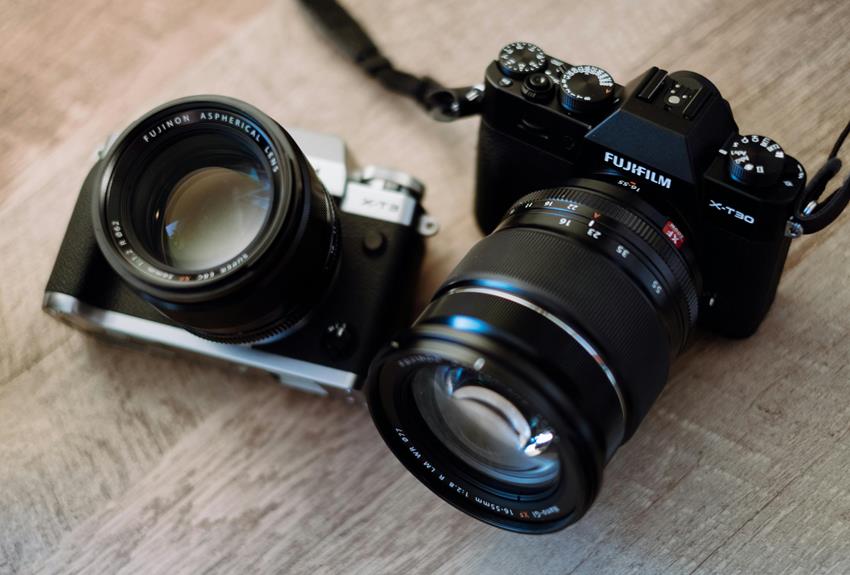
When deciding between mirrorless cameras and DSLRs for your photography needs, you may find yourself contemplating which features will truly enhance your craft. The debate between these two camera types often centers around image quality, autofocus capabilities, size, weight, and lens options. Each has its strengths and weaknesses, but how do these factors truly impact the outcome of your photographs? Let's uncover the nuances that set mirrorless cameras apart from DSLRs and how these distinctions could potentially redefine your photography experience.
Image Quality Comparison
When choosing between mirrorless cameras and DSLRs for photography, you'll notice a distinct difference in image quality. Mirrorless cameras excel in providing high-resolution images due to their lack of a mirror mechanism, allowing for a sharper and more detailed outcome. The electronic viewfinders in mirrorless cameras offer a real-time preview of your image, ensuring you capture the shot exactly as intended.
On the other hand, DSLRs, with their optical viewfinders, may sometimes lead to slight discrepancies between what you see and what the final image portrays.
Mirrorless cameras also have an edge in terms of color accuracy and dynamic range. The advanced technology in mirrorless sensors often results in more vibrant colors and better handling of highlights and shadows. This can be particularly beneficial when shooting in challenging lighting conditions, providing you with more flexibility during post-processing to fine-tune your images.
Autofocus Performance Evaluation
For evaluating autofocus performance between mirrorless cameras and DSLRs, consider how each system tracks and locks onto subjects swiftly and accurately. Mirrorless cameras are known for their advanced autofocus systems that often utilize on-sensor phase detection or contrast detection technology. These systems can quickly acquire focus on subjects, especially in well-lit conditions. They excel in tracking moving subjects due to their ability to continuously adjust focus as the subject moves within the frame.
DSLRs traditionally rely on phase detection autofocus sensors located within the camera body, separate from the imaging sensor. While DSLRs have a proven track record of fast and accurate focusing, especially in low light situations, they may struggle with tracking fast-moving subjects compared to some mirrorless counterparts. Keep in mind that both mirrorless cameras and DSLRs have made significant advancements in autofocus technology, and the differences in performance are becoming less pronounced over time.
When choosing between the two, consider your specific photography needs and the type of subjects you frequently shoot to determine which system best suits your requirements.
Size and Weight Considerations
Considering size and weight when choosing between mirrorless cameras and DSLRs can significantly impact your overall photography experience. Mirrorless cameras are generally smaller and lighter than DSLRs due to the absence of a mirror mechanism and optical viewfinder. This difference can make mirrorless cameras more portable and convenient for travel or long shooting sessions. The compact size of mirrorless cameras also allows for easier handling and discreet shooting in various environments.
The reduced weight of mirrorless cameras can be less straining on your hands and shoulders during extended use, making them a preferred choice for photographers who value comfort and mobility. Additionally, the lighter weight of mirrorless cameras can be advantageous when shooting handheld or when using camera stabilizing equipment.
Lens Selection and Compatibility
Size and weight considerations play a significant role in how mirrorless cameras and DSLRs differ, and this contrast also extends to the realm of lens selection and compatibility. Mirrorless cameras are known for their compact size and lightweight bodies, which often results in smaller lenses compared to DSLRs. The reduced flange distance in mirrorless systems allows for more flexibility in lens design, leading to innovative and portable options.
When it comes to lens compatibility, mirrorless cameras have a range of options available. Adapters can be used to mount DSLR lenses on mirrorless bodies, although this may impact autofocus speed and performance. Additionally, many mirrorless camera manufacturers have been expanding their native lens offerings, catering to various photography needs.




